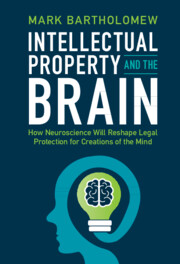 Intellectual Property and the Brain
Intellectual Property and the Brain Book contents
- Intellectual Property and the Brain
- Intellectual Property and the Brain
- Copyright page
- Contents
- List of Figures
- Acknowledgments
- Introduction
- Part I The Law and Neuroscience of Creative Activity
- Part II Understanding Audiences for Art and Advertising
- 3 Neuroaesthetics and Copyright Infringement
- 4 Seeing Design
- 5 Neuromarks
- Part III Using Neuroscience to Improve Intellectual Property Law
- Index
3 - Neuroaesthetics and Copyright Infringement
from Part II - Understanding Audiences for Art and Advertising
Published online by Cambridge University Press: 14 July 2022
- Intellectual Property and the Brain
- Intellectual Property and the Brain
- Copyright page
- Contents
- List of Figures
- Acknowledgments
- Introduction
- Part I The Law and Neuroscience of Creative Activity
- Part II Understanding Audiences for Art and Advertising
- 3 Neuroaesthetics and Copyright Infringement
- 4 Seeing Design
- 5 Neuromarks
- Part III Using Neuroscience to Improve Intellectual Property Law
- Index
Summary
The current test for copyright infringement requires a court or jury to assess whether the parties’ works are “substantially similar” from the vantage point of the “ordinary observer.” Embedded within this test are several assumptions about audiences and art that neuroaesthetics—the study of the neural processes underlying aesthetic behavior—calls into question. To illustrate the disconnect between the law’s understanding of aesthetic appreciation and the reality of our reactions to works of art, the chapter explores a recent high-profile copyright matter involving the rock anthem “Stairway to Heaven.” Under current law, no effort is made to select jurors with the same listening or viewing tastes as the target audience for the original work—in this case, fans of classic rock. Nor can expert witnesses aid the jury’s understanding of that target audience. Instead, the assumption seems to be that we all appreciate works in the same indescribable way and one person’s reaction is as good as another. In truth, the basic biology of aesthetic reaction changes markedly depending on familiarity, experience, and even gender, contradicting copyright law’s one size-fits-all-approach.
Keywords
- Type
- Chapter
- Information
- Intellectual Property and the BrainHow Neuroscience Will Reshape Legal Protection for Creations of the Mind, pp. 57 - 87Publisher: Cambridge University PressPrint publication year: 2022


